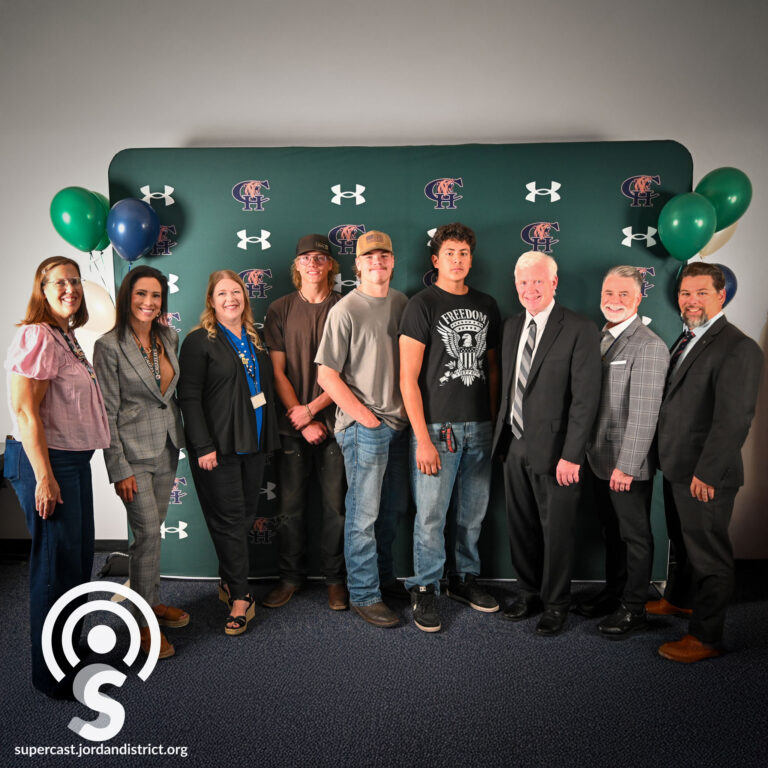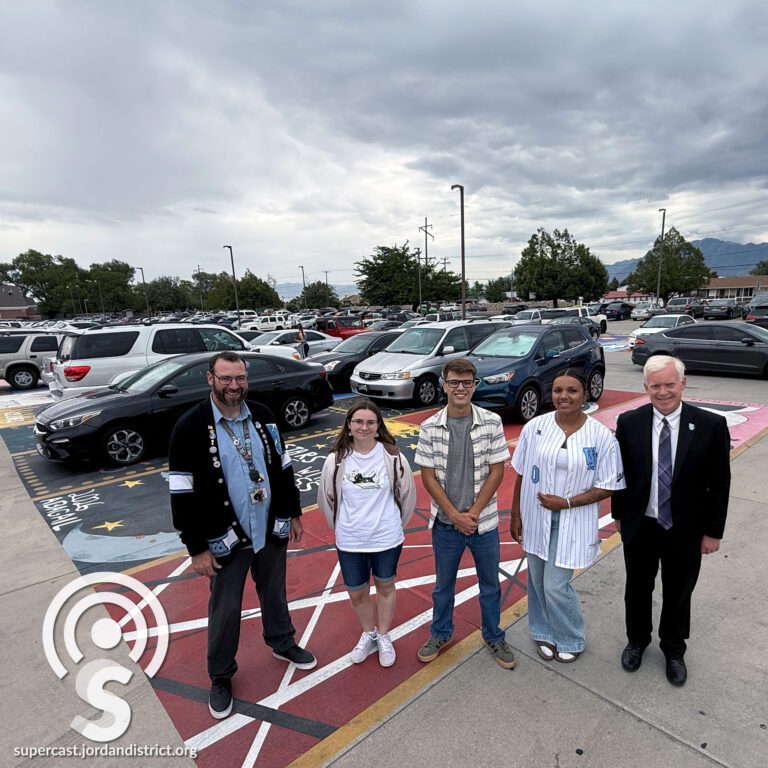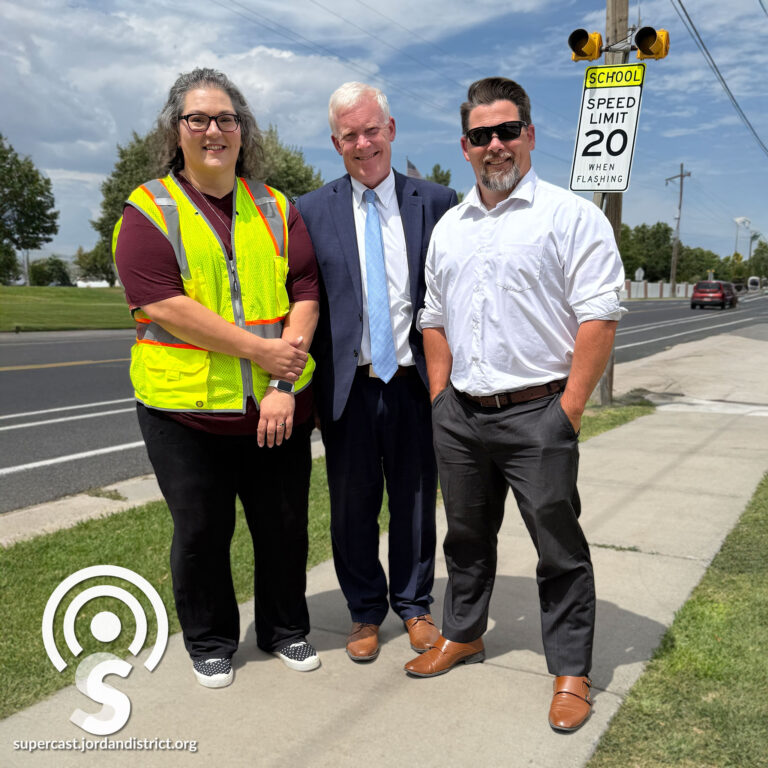They are students at Copper Hills High School who recently risked their own lives by breaking down a front door and running into a burning home hoping to save the lives of others.
On this episode of the Supercast, join us as we take you inside the big surprise where the students received a military style “Honor of Excellence” award for going above and beyond and being exemplary citizens.
Audio Transcription
Heidi Jacobson:
They're heroes, honestly. Carter's like, "I'm not a hero.” He just did what he thought was right.
Cammerin Inselsberger:
My buddy Gabriel came outside and said, "Hey, there's a fire down the street." And then I remember Carter looking distinctly at me and said, "Well, come on, let's go do something."
Zera Gonzales:
We truly saw our sense of community in our neighborhood, especially with our boys again. We're so willing and selfless and risked so much.
Anthony Godfrey:
Hello and welcome to the Supercast. I'm your host, Superintendent Anthony Godfrey. They are students at Copper Hills High who recently risked their own lives by breaking down a front door and running into a burning home, hoping to save the lives of others. On this episode of the Supercast, join us as we take you inside the big surprise where the students received a military-style Honor of Excellence Award for going above and beyond and being exemplary citizens.
Anthony Godfrey:
We take you now to the ceremony honoring the boys who saved two dogs.
Female Voice:
We would like to reunite you this morning with Rocky and Simba, who you saved, and we'd have the Gonzales family come on in with the animals. They want to thank you.
Matt Alvernaz:
My name is Matt Alvernaz. I'm the Safety and Security Director for the Jordan School District. During my 20 years of combined service in both the military and law enforcement, I've had the privilege of taking part in the longstanding tradition of the Challenge Coin. The Challenge Coin is something that is given as a token of appreciation and respect for those who go above and beyond the regular everyday expectations of society. Each of these coins, as we give them out there, they're unique and there's only so many made. So once you're given one, then hang on to it. They’re never going to be made again. There's something that gets collected and it's something that's honored among the uniform services and the tradition I want to carry out and give to you guys. So these coins, they're honored in a way of a traditional handoff and it's given through a handshake. Everything on this coin means something. If you guys want to go over what they all represent, you can do that. So I want to congratulate you guys in the traditional way.
Boys:
Thank you.
Anthony Godfrey:
We're talking now with the three students who saved the two dogs from the fire in West Jordan City. Thank you very much for taking time. Will you introduce yourself and tell us your name, grade, and what programs you're in?
Cammerin Inselsberger:
My name is Cammerin Inselsberger. I am a senior at Copper Hills High School and I am in no current programs, but I was in diesel tech.
Carter Jacobson:
I'm Carter Jacobson. I go to Copper Hills. I am a senior as well and I'm in the diesel program at J Tech.
Gabriel Hernandez:
I'm Gabriel Hernandez and I'm a senior at Copper Hills and I'm also in the J Tech diesel program.
Anthony Godfrey:
So did you know each other before the diesel program or is that how you met?
Carter Jacobson:
No, we knew each other before. I knew Cammerin for like three years. He kind of introduced me to it.
Anthony Godfrey:
Why don't you talk me through what happened, everything from spotting the fire to going in and saving the dogs?
Cammerin Inselsberger:
We were doing yard work out back at my house and then we went. My buddy Gabriel came outside and said, "Hey, there's a fire down the street." And then I remember Carter looking distinctly at me and said, "Well, come on, let's go do something." And so I jumped the fence. They ran around and we just ended up down the street and just seeing if anybody was there that was getting hurt or something.
Anthony Godfrey:
When you first arrived, what did you think? Did you think that maybe there was somebody in the house?
Gabriel Hernandez:
We did after we saw the truck in the driveway and the neighbor in front of the house telling us that they haven't checked on the house yet. They just saw the fire. So we went to the window to see if there was somebody inside and we kept banging on the door. Nobody answered and Carter sees a little dog running across the hallway.
Anthony Godfrey:
That was enough to decide.
Gabriel Hernandez:
That was more than enough.
Anthony Godfrey:
There are dogs in there and we need to get in there.
Gabriel Hernandez:
Yeah.
Anthony Godfrey:
Now I watched on the camera how you approached the door. Tell me about working on getting in the front door.
Carter Jacobson:
I think my buddy's dead. Cammerin’s dead. He tried to shoulder the door first. And then I think they were thinking about breaking down the window, but I was like, "I'm just going to try to kick the door." Donkey kicked it. And so it started working. The bottom of the door cracked. I didn't let game everyone else's motivation to keep going. We kicked it down.
Anthony Godfrey:
Now you kicked it facing the door and then the donkey kick turned around.
Carter Jacobson:
I knew kicking it forward wouldn't work anymore. And then kicking it like a donkey kick would be more better because my foot’s more like flush to the door. I don't know. It was just something I thought about.
Anthony Godfrey:
In the moment you just thought about trying something different. What I was impressed with is that you didn't say, "Well, he tried to shoulder. I tried to kick it in. It didn't work." You just kept going and kept trying to be sure that you got in.
Carter Jacobson:
Yeah, it was either that or the window.
Anthony Godfrey:
When you got in, you still didn't know whether it was just dogs or whether there was someone in there who had maybe passed out or whatever. So what did you do once you got in?
Gabriel Hernandez:
I ran straight for the bathroom thinking it was a bedroom and then the propane tank caught fire and shot fire right through the window.
Anthony Godfrey:
Wow. What went through your mind at that moment?
Gabriel Hernandez:
I should get out of there.
Anthony Godfrey:
So where were the dogs when you got in?
Carter Jacobson:
I think they were... So when we walked in, Gabriel went to the bathroom and I saw the dog dart towards the kitchen. So when I walked in, they were just sitting in the laundry room, curled up in the corner. The big dog was kind of laying in front of the smaller dog protecting it.
Anthony Godfrey:
When you approached the dogs, did you have to carry them out or were you able to help them out?
Carter Jacobson:
No, we had to carry them out.
Anthony Godfrey:
Did they let you approach?
Carter Jacobson:
Yeah.
Anthony Godfrey:
I wondered whether in that moment they might be afraid and might not be cooperative as you're trying to say that.
Cammerin Inselsberger:
Yeah, they were mostly cowered down in the corner of the laundry room and so they didn't try to fight back or anything. So it's not like either of us three got hurt by the dogs because they knew something was up and so it was more so just letting us take them.
Anthony Godfrey:
Describe what it looked like inside the house. What was that like?
Carter Jacobson:
It was more... I feel like it was quiet. It was more calm before the storm because when we got in there, the side of the house was on fire. It wasn't as intense. But as soon as we got out, the rest of the house started catching on fire and the smoke detectors went off.
Anthony Godfrey:
How soon after you left the house did the fire department arrive?
Carter Jacobson:
I would say a minute after. A couple of minutes after. It was more hectic for them to get in because people were trying to drive down and see the fire and walk down so there was a lot of people blocking the street.
Anthony Godfrey:
Now the fire department said that you were helpful because you were first on scene. What was some of the information that you shared with them that was helpful?
Cammerin Inselsberger:
We saw that their propane tank started catching fire from the trailers because there was a trailer and there was one propane tank on it and there was another one on the ground. But there were also two in the back of the trailer so we were able to tell them that we saw the fire start in the back area of the house next to the house that we're in now.
Anthony Godfrey:
So they were able to see, they were able to better understand what happened because you were there. One of the things that we've trained our employees on over the years is that when you come up on an emergency you don't wait for someone else to come. You jump in and you do everything that you can. A lot of times people wait for an expert, you know, someone is bleeding or someone is hurt and they wait until someone else comes to do it because they're afraid of making a mistake. But I'm so impressed with the courage that you showed jumping in and just doing what needed to be done. Can you remember what was running through your mind as you went into the house?
Cammerin Inselsberger:
Honestly, I can't remember anything. That adrenaline hit and I just, I remember going to the door, banging on the door, ringing the ring doorbell like 20 times. And then we got in and then that was it.
Anthony Godfrey:
How long did it take for the adrenaline to dissipate?
Cammerin Inselsberger:
I don't think it did until I went to bed that night.
Zera Gonzales:
I have my dog saved. Thank you so much.
Anthony Godfrey:
How does it feel to be recognized like this today?
Boys:
Grateful.
Just proud that we did something good.
Makes me look back at the community, see what else we need help with and what we can improve with.
Anthony Godfrey:
Well, thank you for being a great example to other students and really to everyone who served this story and thanks for taking the time to talk with us today. Stay with us when we come back. We'll talk with the family whose dogs were saved.
Male Voice:
Never miss an episode of The Supercast by liking and subscribing on your favorite podcasting platform. Find transcripts for this episode and others at supercast.jordandistrict.org.
Female Voice:
Does your student want to become a veterinarian, commercial pilot, programmer? Maybe they want to make a difference as a dental assistant. These are just some of the programs offered as part of Career and Technical Education, CTE, in Jordan School District. CTE provides the technical skills needed to prepare students for future employment or for a successful transition to post-secondary education. Career and Technical Education provides work-based learning opportunities. We partner with industry experts to offer apprenticeships and internships with students working in the real world at real jobs while going to school. The CTE experience starts in our elementary schools with The Kids' Marketplace and grows through middle and high school. To explore all CTE has to offer in Jordan School District, visit cte.jordandistrict.org today and let's get your child started on the pathway to a profession
Anthony Godfrey:
We're talking now with the family of the two dogs that were rescued. Introduce yourself.
Zera Gonzales:
Hi, yes, my name is Zera Gonzales.
Anthony Godfrey:
Zara, tell me about how it felt for your family. First of all, to learn that there was a fire, how's your house, and then to learn that the dogs were okay.
Zera Gonzales:
Truly, it was devastating. Obviously, something that was never expected to happen to us. But we truly saw our sense of community in our neighborhood, especially with our boys again, that were so willing and selfless and risked so much to enter our home. They're the very first ones that entered and saved both of our dogs, which are a big part of our family and it means so much to us. But yeah, it was such a relieving feeling knowing that coming onto the site, still seeing our home being up in flames, but knowing that both of our dogs were out safe and with the boys.
Anthony Godfrey:
I'm just glad that your family is safe and the dogs are safe. Tell me about your home and what happens next for you.
Zera Gonzales:
So essentially our home is unsalvageable. We've been told that it needs to be pretty much fully reconstructed. We are still waiting, it's a waiting game at the moment. We're still waiting to hear back from insurance and that whole process of hopefully down the line will be a lot sooner than anticipated. But yeah, it is a waiting game and we're just hoping that everything will smooth out later on. We're currently living right across the street in the neighbor's home. He's renting it out and that's our long-term rental for now.
Anthony Godfrey:
Wow. I can't even imagine what you're going through. Tell me about your... Tell me about the first time you had the opportunity to talk with the boys who'd saved — is it Rocky and Simba? Is that right?
Zera Gonzales:
That is correct.
Anthony Godfrey:
We'll talk with Rocky and Simba in a moment, but tell me what it was like to first meet the boys who saved them.
Zera Gonzales:
Yeah, well first of all, we pretty much first saw through our ring camera who were the individuals knocking down on the door, and we noticed that it was the neighbors. They live a couple houses down. And again, we just did not expect that they would be the ones that were first on site and breaking down the door to save our dogs. But it was such a relieving feeling and again, being so thankful to them right after knowing that they were the ones that entered the home. While the firefighters are still trying to put out the fire, we were able to talk to them and be like, "Hey, again, we're so eternally grateful to you guys because our family's whole because of you."
Anthony Godfrey:
I love the way you said that and you have a lot to deal with. What a devastating situation. But it's good to know that you have people around you that are going to support you through a difficulty like this. It's really a test of the community.
Zera Gonzales:
Yes, it truly is. Again, we've only been living in our home — we were heading towards two years. Just knowing that those individuals took that initiative and acted out and were able to be the ones that entered our home again, it was such a relieving feeling. And we're, again, eternally grateful.
Anthony Godfrey:
What about Rocky? Rocky is the big one and then we've got Simba here. What kind of dogs are they?
Zera Gonzales:
Yes. Rocky is a German Shepherd, Rottweiler, Husky mix.
Anthony Godfrey:
And a very good boy.
Zera Gonzales:
Yes, very good boy. And then over here we have Simba. He is a Maltipoo. That's a Maltese-poodle mix.
Anthony Godfrey:
Also a very good boy.
Zera Gonzales:
Yes.
Anthony Godfrey:
Not Simba. You're not second. You're both number one in our hearts.
Zera Gonzales:
Exactly. Exactly.
Anthony Godfrey:
We're talking now with Carter's mom. Introduce yourself, please.
Heidi Jacobson:
My name's Heidi Jacobson.
Anthony Godfrey:
Heidi, you and I have known each other for a little while.
Heidi Jacobson:
Yes, we have.
Anthony Godfrey:
Tell everyone about that.
Heidi Jacobson:
Mr. Godfrey was my eighth-grade teacher out at Bingham Middle School.
Anthony Godfrey:
Bingham Middle School days were great days.
Heidi Jacobson:
Yes, they were. I actually am the first graduating class from Copper Hills High School.
Anthony Godfrey:
Oh, yeah. That's right. That's pretty cool. So now to have your son here, what does that mean?
Heidi Jacobson:
It's just all four of my kids have come here. And to have Carter be the caboose, he actually will graduate for my 30th class reunion.
Anthony Godfrey:
Wow. That's awesome. Your son graduating from the same school 30 years later. And how proud are you of Carter right now?
Heidi Jacobson:
Those boys are incredible boys, and they deserve all of this recognition and all the publicity and everything that they are getting because they would do it again today. They're just those type of boys. They're incredible.
Anthony Godfrey:
Talking with them, I really got that sense that they'd do it again and that's just who they are. Your son is a large boy. He was able to kick that door in a way that I'm not sure I would have been able to.
Heidi Jacobson:
He said the adrenaline just kicked in once he saw those dogs through the window. He was like, “I knew no one was home.” We have dogs that are part of our family and would be devastated, so all three of those boys just knew that they had to get in there and save family members. Even though they're furry, they're still family members.
Anthony Godfrey:
He, it didn't surprise you at all that you did what he did.
Heidi Jacobson:
No, no, it didn't. They're heroes, honestly. Carter's like, “I'm not a hero. I just did what I thought was right.” I'm proud of him.
Anthony Godfrey:
What does it mean to see them recognized like this?
Heidi Jacobson:
It actually makes me pretty emotional. He's a great kid, like I said. They deserve all of this and makes my mom a heart happy.
Anthony Godfrey:
Well, it's great to see you and we're all very proud of what they did. It's wonderful to meet your son.
Heidi Jacobson:
Thank you so much, Mr. Godfrey.
Anthony Godfrey:
Thank you. We're talking with Matt Alvernaz, our school safety coordinator. What does it mean to you today to honor these boys?
Matt Alvernaz:
It is a great privilege to be able to share this tradition in honoring things that are above and beyond the regular everyday parts of society. These young men did something that normal people wouldn't do, especially today. We see people pull out their phones and record and watch. And yeah, we have this great video of things out there. But these young men, who had no obligation to do otherwise, stepped up, addressed the problem and went right out without waiting and did an amazing job.
Anthony Godfrey:
And they don't seem terribly impressed with themselves. This is just what needed to be done. And they did it.
Matt Alvernaz:
Yeah, their level of humility is actually what's most impressive. It's more of like they're not after this attention that we're given. So that's all the more reason to shower them with it. But they are just like, "What? This is normal. Who wouldn't have done this?" And reality is, most people wouldn't.
Anthony Godfrey:
Tell us about the challenge coin you gave them to honor what they've done.
Matt Alvernaz:
So these challenge coins are part of a long-standing tradition given through military and law enforcement and uniform services typically. Here at Jordan School District, we have our own challenge coin to be able to recognize these outstanding kind of things as well, because we understand that there's more to it in everyday society in our students. We want to emulate what needs, what we like to see from society, you know, heroes and things and what these people can do. And so this coin has significance. Every coin means something. So here on this front-facing part, we have a police badge-style shield with the Jordan “J” emblem in it. Then behind that, you have the shoulder patch, which again represents first responders, you see that on fire departments and police officers. Then that is filled in with a navy blue, which represents authority and stability and loyalty. Behind the shield, you see three lines kind of crossing behind it. And the shield represents the safeguarding of the physical, mental and emotional well-being of our students and staff and everybody within our district. Below it, there's three stars that are propping up the shield. Those three stars represent the community, the school district and our first responders working together to prop this up and make sure that shield stays strong. On the backside, it says we're honoring excellence and you'll see the same three lines of what we're honoring and those three stars as well and with a ring of blue around it again to represent that stability, authority and circling what we're doing.
Anthony Godfrey:
Well, thank you very much for honoring these students and it's a great new tradition. I know there are going to be many other opportunities to honor incredible students here in Jordan District.
Matt Alvernaz:
Absolutely.
Anthony Godfrey:
Thanks for joining us on another episode of the Supercast. Remember, “Education is the most important thing you'll do today!” We'll see you out there. Bye. Bye.
(upbeat music)





